Mining history of Almeria looking at the British influence
By Nick Nutter | Updated 28 Jun 2022 | Andalucia | History |
Login to add to YOUR Favourites or Read Later
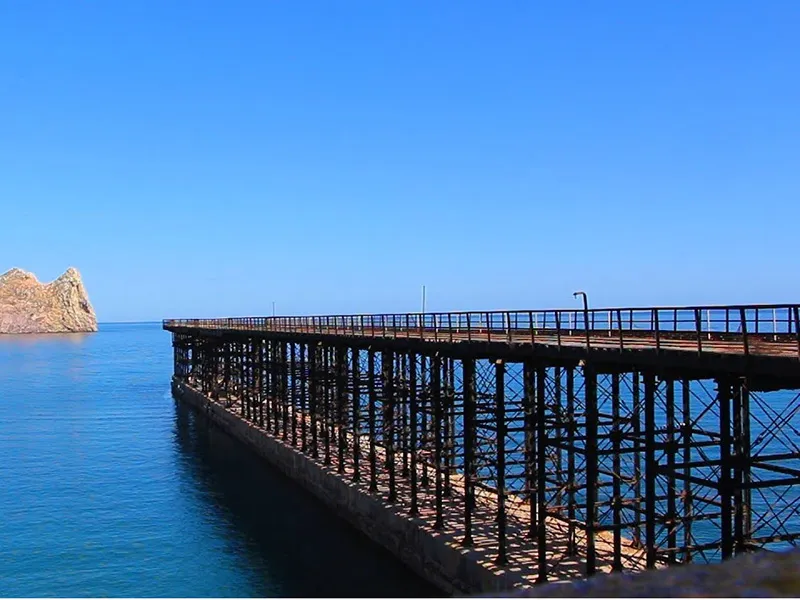

Pier at Hornillo Murcia
Of all the provinces in Andalucia, Almeria probably has the greatest diversity of minerals of use to humans. They range from the exquisite marble of Macael, prized since Roman times, to gold at Rodalquilar, lead in the Sierra Gádor, silver in the Sierra Almagrera, gypsum at Sorbas and the largest gypsum geode in Europe at Pulpi, and iron in the Sierra Alhamilla and from Bedar to Seron along the northern flanks of the Sierra de los Filabres. The whole is connected to ports on the coast, Almeria, Agua Amarga, Carboneras, Garrucha, Villaricos and Aguilas, the latter just over the border in Murcia, by rail, aerial cableways, donkey drawn narrow gauge railways, inclined planes and road.
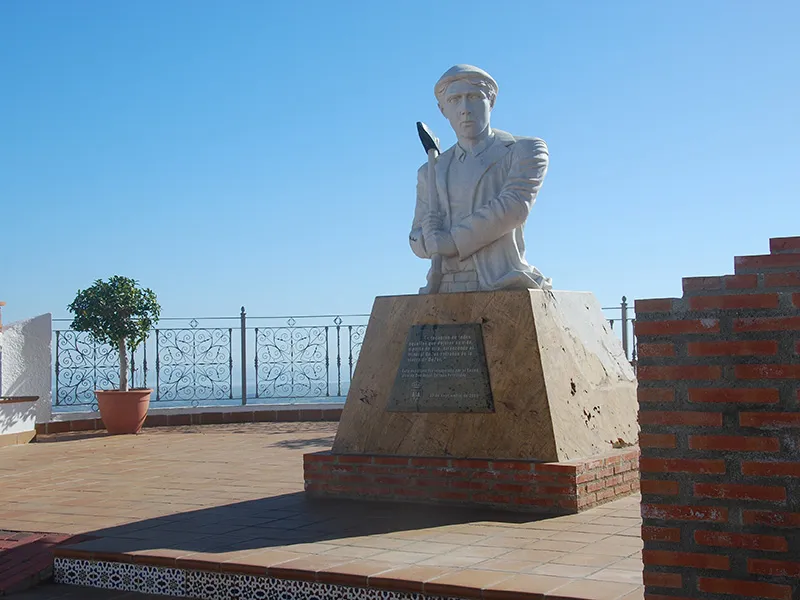
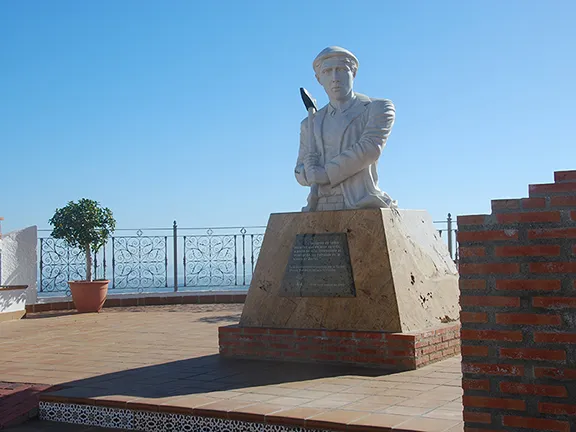
Bedar - monument to miners
In terms of exploitation by British mining companies it is also the province least exploited. The rich silver lead mines of the Sierra Almagrera attracted little British interest. The Sierra Almagrera Mining Company formed in 1872, is one exception. Other British Companies were formed to work with the mine owners and operate the lead smelting plants, for example, the Villaricos Silver Lead Mining and Smelting Company and the Vera Smelting Company. The Aguilas Smelting Company was formed to re-smelt the silver rich slag left from Roman smelting operations. However, all these companies were short lived.

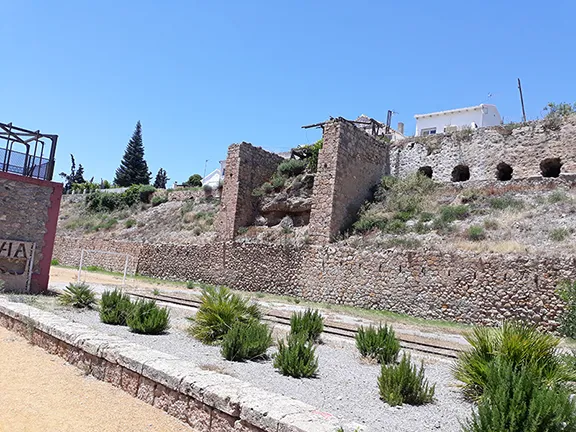
Estacion Seron
Elsewhere in Almeria, Spanish and French companies operated most of the iron mines with occasional British company activity. Examples include the Almeria Iron Ore Company, Almeria Mines, Bacares Iron Ore Mines, Gergal Railway and Mines Company, Garrucha Iron Mining Company and the Alhamilla Mining Company.
That is not to say the British companies had no impact on the area, the ‘Cable Ingles at Almeria’ was the destination of the Great Southern of Spain Railway Company Ltd that connected Almeria with the mines of Granada (already dealt with in the Mining in Granada section) and the Baza to Aguilas line ended at a magnificent pier at Hornillo. Both ore loading facilities still exist.
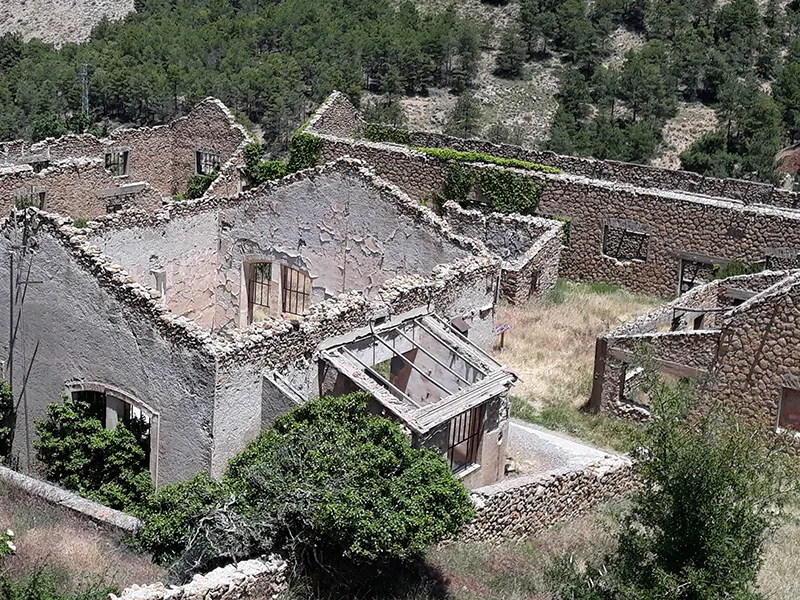
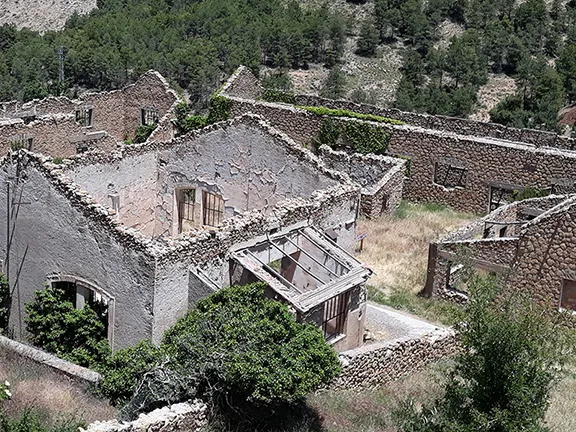
Las Menas
The main mining areas in Almeria are: the Sierra Almagrera; the Sierra de los Filabres - Bedar to the east, Seron to the north, and Gergal to the south; Beires in the Sierra Gádor ; the Sierra de Alhamilla (the western flanks) and Lucainena (the northern flank).
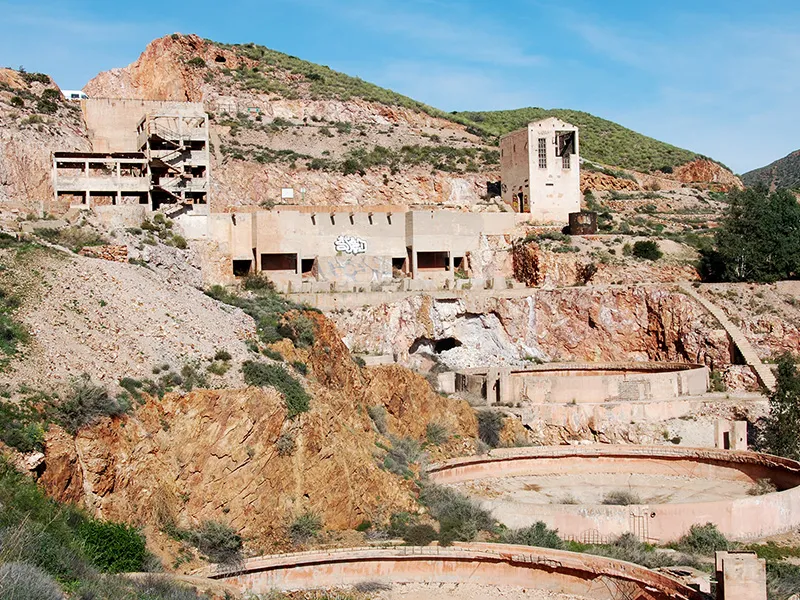

Rodalquilar gold mine
Gold, mixed with lead, was discovered at Rodaquilar in the Cabo de Gata in 1864. The percentage of gold in the lead was low and the extraction process expensive so the Spanish mine owners retained the value of the lead and paid the miners a bonus from the gold residue. In those early days the ore was taken from the mine by explosives and hand tools, and the ore was carried out of the mine in esparto baskets where it was loaded onto donkey-drawn carts. It was then taken to the coast at Playazo beach and shipped up to foundries at Puerto de Mazarron and Cartagena. At the foundry, lead mixed with gold was extracted and this amalgam was then shipped to Antwerp where it was separated out using a process known as amalgamation that uses highly toxic mercury. The value of the gold was assessed at the foundries and the miners themselves received that value in cash, less 25% for transport costs.
In 1915 gold was discovered in free form in the ‘Maria Josefa’ mine and the profits allowed the owners to install their own amalgamation plant that opened in 1925. This company, and the German company that followed, Krup Grusonwerk, found extraction and processing too expensive and could not show a profit.
In 1930, the British owned company, Minas de Rodalquilar SA, introduced new explosives, compressed air drills, laid tracks in the adits and used motorized vehicles to transport the ore to the treatment plant built near the village. The mine started to show handsome profit.
In 1936, at the outbreak of the Spanish Civil War, the mines were seized by the syndicalists, the equivalent of trade unions, signalling the end of British involvement.

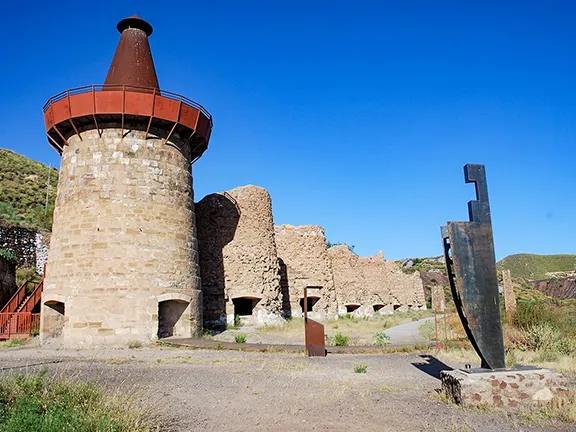
Hornos de Calcinación at Lucainena de las Torres
The Sierra Alhamilla is a limestone massif upthrust from the seabed quite recently in geological terms, about 7 million years ago. The central peaks reach nearly 1,400 metres about 40 kilometres northeast of Almeria city.
One area that did attract interest from British companies was the Baños de Alhamilla, an area rich in iron ore, but again, they were on the periphery, in support as it were. In December 1891, ownership of the rail line from Baños de Alhamilla to the port of Almeria came into the hands of the Alhamilla and Almeria Railway Co. Ltd, owned by a George Stone and C.H. Borner. An aerial cable was built between the Casualidad mine and Baños de Alhamilla. Transportation of ore commenced in May 1893. Unfortunately, the Alhamilla and Almeria Railway Co. Ltd, went bankrupt in 1896. In 1898, the Sierra Alhamilla Mining Company was formed to exploit the Casualidad, Riqueza, and Graciosa claims at Baños de Alhamilla. Unusually, each mine had separate share issues. In 1904 the property passed to the Gergal Railway and Mines Co. Ltd, and in 1907 to the Alquife Mines and Railway Co. Ltd.
The Alquife Mines and Railway Co. Ltd. decided to revitalize the mines, conducting drilling and exploration. By 1904, some 600,000 tons of haematite (iron oxide) had been extracted, hardly touching the fresh siderite (iron carbonate). In the Casualidad mine drilling discovered an area about 10 meters thick rich in complex sulfides of lead and antimony, with a high content of silver, up to 2.35 kg per ton of ore. In a bizarre twist, the company had drilled to such a depth that they had struck water, the same water that supplied the spa at Baños de Alhamilla. When the company started to pump the mine dry, the supply to the spa dried up. The mayor ordered the pumping to stop to preserve the spa.
Over at Lucainena de las Torres, the municipality have taken the opportunity to preserve some of this industrial heritage by preserving one of the eight iron ore kilns. The whole area is scattered with mine workings, the crumbling remains of aerial cableway pillars and the terminus of the Agua Amarga to Lucainena de las Torres narrow-gauge mineral railway.
The Sierra Gádor is located immediately to the west of Almeria city on the south coast of Spain. It is a high (over 2000m), relatively dry, plateau composed of Triassic limestone. The north side of the limestone outcrop is dissected by the east-west aligned valley of the Rio Andarax. Although lead has been found in many locations on the plateau, it tends to be concentrated in three specific areas; between the towns of Fondon and Almócita on the north side of the Rio Andarax, centrally, east of the towns of Berja and Dalias and immediately north and west of Almeria The climate is generally hot in the summer and very cold in the winter, with snow on the ground for up to three months some years. There are occasional periods of heavy rainfall.
The area is relatively isolated with very few access tracks. The mine workings were generally small, shallow and dry so there was no need for massive investment for pumping engines or head gear and the area did not attract the same attention from the foreign investors as other, easier worked areas.
On the northern flanks of Sierra Gádor is the Copper Age site of Los Millares.
Las Menas is 17 kilometres from the small town of Serón, at an altitude of over 1000 metres in a small valley on the northern flanks of the Sierra de Los Filabres. It is extremely hot in summer and deep snow is common in the winter. Small adits had been producing quantities of ion ore when the area was explored by three foreign companies.
Three companies, the Belgian ‘Mines et Chemin de Fer Bacares – Almeria et Extensions’ incorporated in Brussels in 1887, the British ‘Bacares Iron Ore Mines Limited’ incorporated in Glasgow in 1899 and the Dutch ‘W.H. Mullery y Cia’, already operating in Santander, collaborated to exploit the iron in the Sierra de Los Filabres in the municipality of Serón. The Belgian and Dutch companies amalgamated in 1925 to form the ‘Sociedad Minera Cabarga San Miguel’.
Between them the three companies first built a town, Las Menas, that included housing, shops, a hospital, school, Guardia Civil station and a church. For further entertainment they also included a cinema, a bullring and a football pitch. Aerial cable runways transported the ore from the valley down to a specially built loading area at Estación Serón where the ore was loaded into railway trucks on the Baza to Lorca and Aquilas railway, a line the ‘Great Southern of Spain Railway’ between 1870 and 1894. Mining activity continued at Las Menas until 1968, one of the longer surviving mines in Andalucia.
The Sierra Almagrera runs parallel to the Mediterranean coast from Villaricos, 12 kilometres, to Pozo del Esparto, the coastal border between the provinces of Murcia and Almería. The massif is composed of mica schist and slate with veins of galena (lead), argentiferous galena (silver and lead), sphalerite (zinc sulphide), chalcopyrite (copper sulphide), pyrites (iron sulfide), haematite (iron oxide), barite (barium sulphate), native silver (silver in the pure form) and jarosite (a complex sulphate of potassium and iron). The Jarosite is interesting; it requires water to form. It was discovered and named in 1852 after the barranco in which it was found, Barranco del Jaroso. Jarosite has been discovered on the planet Mars. The coastal road passes through cuttings of this bedrock that, on the driest day, shines and glimmers as though running with water. Red iron outcroppings are common on the hillsides. Not surprisingly the area has been mined since the Copper Age or before.
Foreign exploitation in the Sierra Almagrera was seriously hampered by local politics. In 1839, argentiferous galena with a high concentration of silver had been found in the Sierra. This caused a ‘Silver Rush’ with Spanish entrepreneurs buying concessions throughout the area. As tales of the riches to be had grew - mostly false, in 1840 there were only three productive mines out of over 200 concessions, concessions changed hands with investors from Granada, Madrid and Barcelona. Many immediately lost money when they found they had bought concessions that did not exist. This was not a scenario a foreigner wanted to become involved with.
The legitimate concessions were worked in a haphazard way, the only motivation being to extract as much ore as possible at the cheapest price. Consequently, there was no plan. Galleries overran into neighbouring concessions as ore veins were followed with no prospecting or surveys, lawsuits ensued.
Order did not start to appear until the French arrived on the scene in 1881 in the guise of La Compañía de Águilas. They expanded rapidly, not just in the Almagrera and Las Herrerías, but also Águilas, Mazarrón, Lomo de Bas, Bédar, and Cabo de Gato. They introduced pumping machinery that drained their own mines as well as those of their neighbours, the smaller Spanish companies who had not wanted to spend money on machinery. All very benevolent until 1886 when, foreseeing the collapse of the silver market, La Compañía de Águilas pulled out. The pumps were silenced, and the mines flooded, effectively ending mining in the Sierra Almagrera.
The remains of the mining industry are abundant, as much part of the landscape as the barrancos and ridges.
This is a list of the British registered mining companies that came and went in Almeria province. Some prospered, some never got started. There may well be others missing from the list. I have only included those for which there is conclusive information.
Alhamilla (1907) Mining Company, Ltd. Registered: 1907 Dissolved: 1909. Formed to take over part of the interests of the Gergal Railway and Mines Company, Ltd., and an interest in the Alfaro and Los Banos mines.
Almeria and Alhamilla Railways Company, Ltd. Registered: 1891
Almeria Iron Ore Company, Ltd. Registered: 1893. To acquire the Alfaro and Los Banos mines in the Sierra Alahamilla from Herman Borner.
Almeria Mines, Ltd . Registered: 1896 Dissoled: 1898. Formed to acquire iron mines at Bacares, Almanzora Valley - it sold some property to the Soria Mining Company, Ltd.
Almeria Mining Development Syndicate Registered: 1897 Dissolved: 1898
Almeria Quicksilver and Copper Company, Ltd. Registered: 1897 Dissolved:1901 Originally formed to acquire mines in Almeria, but own mines at Castaras, Granada
Almeria Syndicate Co Ltd. Registered: 1891
Bacares Iron Ore Mines, Ltd. Registered: 1899 Dissolved: 1940 Bacares District (Almanzora valley), Almeria - part owned by the Coltness Iron Company (Scotland)
Bacares-Seron Ore Mining Ltd. Almeria Not listed
Bacares-Seron Ropeways Ltd. Registered: 1918 Dissolved: 1932
Bairds Mining Company, Ltd. Registered: 1913 Dissolved: 1949 Alquife
Chorrillo-Almeria Railway Company,Ltd. Registered: 1917
Constancia Lead Mining Company Ltd. Registered: 1858 Dissolved: 1861 London Gazette in 1882
Continental Mining (and Metallurgical) Company, Ltd. Registered: 1899 Silver, lead and iron mines in the District of Cuevas de Almanzora and the Barranco Frances, Sierra Almagrera
Garrucha Iron Mining Company, Ltd. Registered: 1900 Dissolved: 1920 Dissolved in London Gazette 1903. - Ambolo, SanJoaquin, Olaster, Compadre Frasquito, Bedar
Garrucha Land Syndicate Ltd. Registered: 1888 Dissolved: 1895
Gergal Railway and Mines Company, Ltd. Registered: 1901
H. Borner and Company, Ltd (H = Herman) Registered: 1895 In 1893 sold the Alfaro and Los Banos mines (Sierra Alhamilla) to the Almeria Iron Ore Company, Ltd
Herrerias Mines, Ltd. Registered: 1892 Dissolved: 1897 La Virgen de las Huertas and Santa Matilde mines, Cuevas de Almanzora near Vera
Iberian Silver Lead Ore Mining Company mentioned in Mining Journal 1847 Pre-1846 working Sierra Almagrera
Palmers Shipbuilding and Iron Company, Ltd. Registered: 1865 Sold mine to Soria Mining Company
Serena Iron Ore Company Ltd Registered: 1907
Sierra Amagrera Mining Company Ltd. Registered: 1872 Dissolved: 1894
Sierra de Gador Mining Association Unrecorded 1856
Soria Mining Company, Ltd. Registered: 1898 Dissolved: 1923 Two groups of iron mines (The Juanita (5 mines) and Prudencia (6 mines)).
South Campanile (Almeria) Iron Ore Company, Ltd. Registered: 1896
Spanish Marble, Ltd. Registered: 1906
Vera Company Ltd. Registered: 1885 Probably Almeria
Vera Smelting Company, Ltd. Registered: 1891 Dissolved:1895
William Baird and Company Ltd. Registered: 1893 Alquife (Bairds Mining is a Subsidiary from 1913 to work Alquife)
Alarcón, Juan C. Braga, Chordi Jose M C. et al (2003) Geology of the Arid Zone of Almeria. ISBN 978-84-935194-7-6
Christian, Rewitzer & Hochleitner, R. & Fehr, Karl. (2019). Casualidad Mine Baños de Alhamilla, Almeria, Spain (Part I). 5. 8-32.
Davies, M. (2020) Then There Were Mines Vol 1
Jodar J.A.S. (2013) Ingenieros noruegos en las minas de Almería del siglo XIX
Vernon, Robert. (2006). British archival information relating to mining operations in Spain and Portugal. An overview with examples from Andalucia.
Vernon, Robert. (2010). Notes about the lead mines of the Sierra Almagrera, Almería, Spain.
Vernon, Robert. (2016). Research Notes on mule power in the Sierra Gádor, Almeria, Spain: A significant mining landscape -- Notas de investigación sobre el poder mula en la Sierra de Gádor, Almería, España: Un paisaje minero importante. 10.13140/RG.2.1.3032.2160.
Vernon, Robert. (2017). Database of British Registered Mining Companies formed to acquire, and work mines, in Spain and Portugal.
The Great Southern of Spain Railway - Max Kite
Mining in the Sierra Almagrera - Margaret Davies